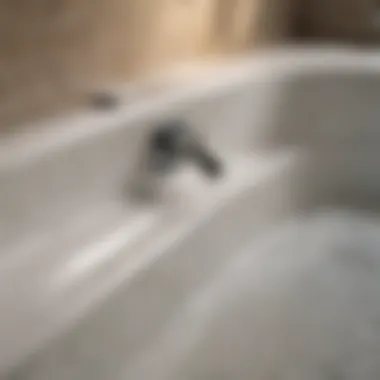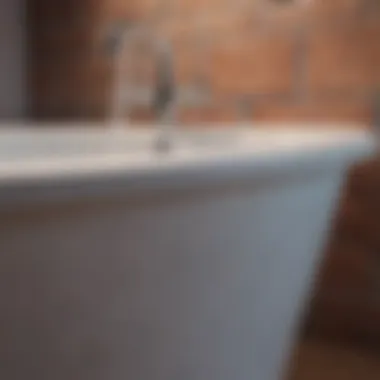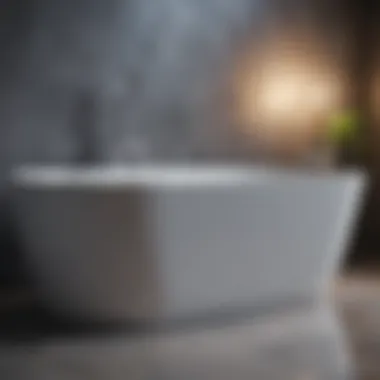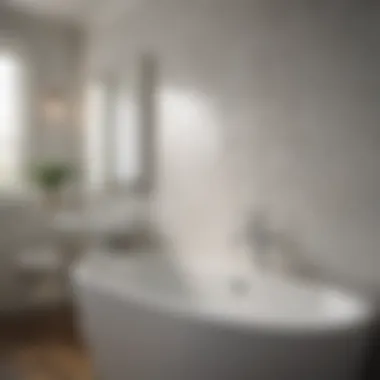Understanding Hard Water Stains in Your Tub


Intro
Hard water stains are a common challenge for many homeowners. This buildup occurs when water, rich in minerals like calcium and magnesium, evaporates on surfaces such as bathtubs. These minerals leave unsightly marks that can compromise both the appearance and hygiene of your bathroom. Understanding the underlying causes of these stains is essential for effective management and prevention.
This article aims to provide a comprehensive guide on identifying and addressing hard water stains in your tub. It offers practical solutions for cleaning, maintaining, and ultimately preventing future deposits from forming.
By keeping your bathroom in good condition, you contribute not only to its aesthetic appeal but also to overall hygiene. With focused attention on these issues, you can look forward to a cleaner, more attractive bathing environment.
Key Insights and Trends
Understanding current trends in bathroom design can enhance your approach to maintaining cleanliness. Many homeowners are prioritizing functional yet stylish designs. The use of materials such as glass and polished metal not only modernizes the space but also minimizes the visibility of hard water stains compared to more textured surfaces.
Additionally, sustainable practices are gaining traction. Homeowners are increasingly using eco-friendly cleaning products to combat hard water stains. These solutions, while effective, often pose less harm to the environment. Making a shift toward biodegradable and natural cleaning agents reflects a growing awareness regarding health and ecological concerns.
Practical Tips and How-To Guides
To effectively address hard water stains, here are several steps you can take:
- Identify the Source
- Cleaning Solutions
- Regular Maintenance
- Inspect your water supply for hardness. If your water contains high levels of minerals, it may be worth investing in a water softener.
- Use vinegar or lemon juice, as their acidic nature helps dissolve mineral deposits.
- Create a paste of baking soda and water. This can be applied to stubborn stains.
- For tougher cases, commercial cleaners designed for hard water stains may be beneficial. Always follow the manufacturer's instructions for best results.
- Clean your tub regularly to prevent mineral deposits from accumulating.
- Wiping down surfaces with a squeegee after each use can limit water evaporation and mineral buildup.
In summary, addressing hard water stains requires a combination of effective cleaning, preventive care, and understanding current design trends. Incorporating these practices will enhance the longevity and appeal of your bathroom, ultimately contributing to a more enjoyable home atmosphere.
Preface to Hard Water Stains
Hard water stains are a common issue faced by homeowners. Understanding these stains is crucial for maintaining not only the hygiene but also the aesthetic appeal of bathtubs.\n\nThe significance of this topic cannot be overstated. Many households have hard water, which contains high levels of minerals such as calcium and magnesium. Over time, these minerals accumulate, forming unsightly stains. These deposits can become stubborn, making cleaning efforts less effective. \n\nSeveral factors influence the formation of hard water stains. Recognizing these factors helps in developing better cleaning practices and preventive measures. It is important to emphasize that addressing hard water stains is not merely about aesthetics but also about hygiene.
Clean bathtubs contribute to overall bathroom sanitation, while neglected stains can harbor bacteria and other pathogens. Knowing how hard water affects your bathtubs can lead to more informed decisions regarding cleaning and maintenance practices. This section sets the tone for what follows, preparing the reader to delve deeper into the causes and characteristics of hard water stains. \n\n### What are Hard Water Stains?
Hard water stains are deposits that form on surfaces exposed to hard water. When water evaporates, it leaves behind mineral residues. These residues can be white, cloudy, or often crusty in appearance. They commonly appear around faucets, along bathtub edges, and in drains.\n\nThe main minerals responsible for these stains are calcium and magnesium, along with small amounts of iron. Though their presence is often harmless, they can create a perceived lack of cleanliness in your bathroom. Without action, these stains harden and become increasingly difficult to remove. Understanding what hard water stains are can guide you in their removal and prevention.
Recognizing Hard Water Effects
Hard water can have additional effects beyond visible stains. One noticeable consequence is the impact on surfaces. For example, porcelain and acrylic bathtubs might show signs of wear if hard water remains on them for extended periods.\n\nAdditionally, hard water can affect your bathing experience. Soap does not lather effectively in hard water, leading to soap scum buildup. This not only detracts from the bathing experience but also contributes to further staining.
Key effects of hard water include:
- Reduced effectiveness of soaps and detergents
- Possible increase in the need for cleaning products
- Potential for foul odors, especially in stagnated water\n\nRecognizing these effects is vital for developing routines that can help mitigate the impacts of hard water. By understanding how hard water interacts with your cleaning efforts and surfaces, you can take appropriate action to protect your bathtub and maintain its aesthetic.
Causes of Hard Water Stains in Bathtubs
Understanding the causes of hard water stains in bathtubs is essential to effectively manage and prevent them. Hard water is the result of high mineral content, particularly calcium and magnesium. This mineral buildup not only affects the aesthetic appeal of your tub but can also impact its longevity and hygiene. Recognizing these factors offers invaluable insights for homeowners who strive for a clean and well-maintained bathroom.
Mineral Composition in Water
The primary culprits behind hard water stains are the minerals dissolved in the water supply. When water evaporates, it leaves these minerals behind, creating deposits. In many areas, hard water can be due to geological conditions where limestone or chalk is prevalent.
- Calcium and Magnesium: These two minerals are the main contributors to hard water. Their accumulation can lead to noticeable rings or spots on bathtub surfaces.
- Iron: In some cases, iron can mix with the calcium and magnesium, causing unsightly orange or brown stains.
- Other Minerals: Depending on the water's source, other minerals like manganese and silica might also be present, leading to different types of stains.


Keeping track of the mineral composition in your water is significant. It functions as a precursor to effectively selecting the appropriate cleaning solutions or preventive measures.
The Role of Water Temperature
Water temperature plays a crucial role in the formation of hard water stains. Hot water tends to evaporate faster than cold water, often leaving behind a higher concentration of minerals.
- Hot Water Systems: Bathtubs that regularly use hot water may see more rapid buildup of stains compared to those using cooler water.
- Evaporation Rates: Higher temperatures mean quicker evaporation rates, which can lead to a more concentrated mineral deposit if not managed properly.
- DIY Hot Water Care: If you often run hot baths, consider incorporating cooling periods or regular cleanings to counteract the effects of heat on mineral deposits.
In summary, understanding the causes of hard water stains in bathtubs pivots around knowing the mineral makeup of your water supply and its temperature usage. By addressing these two aspects, you can take effective steps toward maintaining a stain-free and hygienic bathtub.
Characteristics of Hard Water Stains
Understanding the characteristics of hard water stains is essential for homeowners who want to maintain their bathroom's aesthetics and hygiene. Hard water stains can cause significant damage and inconvenience if left untreated. Therefore, it is helpful to identify the visual aspects of these stains and their impact on various surface materials. This section provides insights into how to recognize hard water stains effectively and understand their implications.
Visual Appearance of Stains
Hard water stains appear in different forms, primarily as white or cloudy spots on the bathtub's surface. The minerals in hard water, such as calcium and magnesium, leave behind deposits when water evaporates. Over time, these deposits accumulate, creating noticeable patches.
Some common visual characteristics include:
- White or chalky residue: This is usually the most evident sign of hard water. It results from mineral buildup.
- Yellow or brown discoloration: In some cases, stains may have a yellowish or brownish tint. This can occur when dirt or soap scum interacts with mineral deposits.
- Glossy or dull finish: The surface may either lose its shine or develop an unnatural gloss due to the presence of these stains.
Recognizing these visual cues will help homeowners take timely action to clean and maintain their bathtubs, preventing more severe damage.
Impact on Surface Materials
Hard water stains adversely affect various bathtub materials, including porcelain, acrylic, and fiberglass. Each material reacts differently to mineral deposits, often leading to specific challenges.
- Porcelain: This material can stain relatively easily. The minerals can etch into the surface, making it challenging to restore a clean appearance without professional cleaning.
- Acrylic: While this material resists stains to some extent, the buildup of minerals can still occur. If not addressed, stains may become permanent.
- Fiberglass: Similar to acrylic, fiberglass tubs can show signs of mineral buildup. In some cases, the sheen may dull, resulting in an unappealing look.
It's important to address hard water stains promptly to prevent long-term damage to your bathtub surfaces.
Additionally, regular cleaning helps protect the integrity of materials. Choosing appropriate cleaning solutions based on the tub's material is also vital for maintaining its condition. Understanding these impacts can help homeowners make informed choices about care and maintenance.
Health Implications of Hard Water Stains
Understanding the health implications of hard water stains is crucial for homeowners aiming to maintain cleanliness and hygiene in their bathrooms. The presence of these stains is not just an aesthetic concern; it could lead to more significant health issues if not addressed properly. This section will delve into two key areas: bacterial growth and hygiene, and the possible skin irritations linked to hard water.
Bacterial Growth and Hygiene Concerns
Hard water can lead to the accumulation of minerals such as calcium and magnesium in your bathtub. These minerals can create an ideal breeding ground for bacteria and mold.
When these microorganisms proliferate, they can pose serious health risks. Common bacteria can flourish in the crevices of hard water stains, leading to issues potentially affecting skin health. Regular cleaning routines that overlook hard water deposits might encourage this growth.
Moreover, the presence of bacteria in your bathing environment can compromise hygiene. It elevates the risk of infections and other health-related problems, particularly for children or individuals with weakened immune systems. It’s essential to monitor stained surfaces and address them promptly by employing effective cleaning methods that mitigate this risk.
Regular maintenance and cleaning can significantly reduce the possibility of harmful bacteria thriving in your bathtubs.
Skin Irritations Linked to Hard Water
Individuals with sensitive skin are particularly susceptible to irritations caused by hard water. The minerals in hard water can lead to dryness, redness, and irritation after contact. The soap scum that forms when soap interacts with hard water can exacerbate these skin conditions by clogging pores.
Common issues include eczema and dermatitis, which may worsen in environments with high mineral content. Those prone to such conditions should be vigilant about their bath environments. Finding appropriate cleaning products that can effectively remove hard water stains without leaving behind residue is vital.


To reduce the chances of skin irritations, consider utilizing water softening techniques or engaging in regular cleaning practices that eliminate hard water deposits effectively.
Cleaning Solutions for Hard Water Stains
Cleaning hard water stains is vital for maintaining the integrity and appearance of your bathtub. These stains, primarily a result of mineral deposits, can dull the shine of surfaces and create a less hygienic environment. Moreover, addressing these stains effectively can extend the lifespan of your bathtub materials while enhancing the overall aesthetic of your bathroom. This section will explore both commercial and natural cleaning solutions, discussing their efficacy, safety, and considerations for use.
Commercial Cleaners: Efficacy and Safety
When it comes to tackling hard water stains, many homeowners turn to commercial cleaners. These products often contain acids, such as hydrochloric acid or phosphoric acid, which are effective at dissolving mineral deposits. Their effectiveness is usually evident soon after application, making them appealing for quick cleaning tasks.
However, safety should be a significant consideration when using commercial cleaners. The fumes from these products can be harsh and irritating. It's important to ensure adequate ventilation when using them. Additionally, many commercial cleaners can be damaging to certain bathtub materials, particularly if they are not specifically designed for those surfaces.
- Pros of Commercial Cleaners:
- Cons of Commercial Cleaners:
- Quick results.
- Generally formulated for hard water stains.
- Wide availability in stores and online.
- Potential harm to surface materials.
- Possible health concerns due to chemical exposure.
It’s advisable to carefully read the instructions and ingredients of any cleaner. Conducting a patch test on a small, inconspicuous area before full application can help ensure there are no adverse effects.
Natural Remedies for Hard Water Stains
For those who prefer a more eco-friendly approach, natural remedies can be effective against hard water stains. Simple ingredients such as vinegar, baking soda, and lemon juice can be used as alternatives to commercial cleaners. These natural options are less harsh and often safer for both the environment and your health.
- Vinegar: White vinegar is a popular choice. Its acetic acid helps dissolve mineral deposits. Mix equal parts of water and vinegar, then spray on the stained area. Allow it to sit for 15 minutes before scrubbing and rinsing.
- Baking Soda: When combined with vinegar, baking soda creates a potent cleaning solution. It acts as a gentle abrasive while the vinegar tackles the mineral buildup. Use it as a paste for added effectiveness.
- Lemon Juice: The citric acid in lemon juice can also break down hard water stains. Apply it directly to the stain, let it sit, and then rinse off.
These natural remedies offer a dual benefit: they help clean without the need for harsh chemicals, and they typically have lower costs associated with their use. However, the effectiveness may take longer than with commercial options.
In summary, both commercial cleaners and natural remedies provide viable methods to combat hard water stains. Understanding the safety and effectiveness of each approach can assist homeowners in making informed decisions appropriate for their specific circumstances.
Preventive Measures Against Hard Water Stains
Preventive measures against hard water stains play a crucial role in maintaining the cleanliness and appearance of your bathtub. These measures not only enhance the aesthetic appeal of your bathroom but also significantly reduce the time and effort required for cleaning. Taking the right steps can minimize mineral buildup, ensuring a hygienic environment and prolonging the lifespan of your tub's surface materials.
Regular Cleaning Routines
Maintaining a regular cleaning routine is essential in preventing hard water stains. By consistently cleaning your bathtub, you can remove buildup before it hardens and becomes difficult to eliminate. Here are some key points to consider:
- Frequency: Aim for weekly cleanings. This discourages the accumulation of minerals and keeps your tub looking fresh and inviting.
- Products: Use mild cleaning solutions specifically designed for hard water stains. Avoid harsh chemicals that can damage the surface of the tub. Look for products containing citric acid or vinegar, as they effectively break down mineral deposits.
- Technique: Employ a soft cloth or sponge for cleaning. Abrasive scrubbers may scratch the surface, making it more prone to stains.
Implementing a structured cleaning routine will not only mitigate staining but will also help you spot any potential issues early, ensuring your bathroom remains in top condition.
Water Softening Solutions
Another effective approach to preventing hard water stains is the use of water softening solutions. These systems address the underlying cause of hard water by removing excess calcium and magnesium ions from the water supply. Consider these options:
- Water Softener Systems: Installing a whole-house water softener can provide long-term benefits by treating all water entering your home. This system exchanges harmful minerals with sodium, effectively reducing hardness levels.
- Point-of-Use Softeners: If a whole-house system is not feasible, portable water softeners can be used directly on your washing machine or sink taps. They are more affordable and easier to install.
Using softened water has the added advantages of improving soap effectiveness, enhancing lather, and even extending the life of plumbing fixtures and appliances.
By adopting a combination of regular cleaning routines and investing in water softening solutions, homeowners can substantially reduce the occurrence of hard water stains in their tubs. This proactive approach not only saves time and money but also encourages a more hygienic and pleasant living environment.
Maintenance Practices to Reduce Hard Water Stains


Maintaining your bathtub is vital for both aesthetic and functional reasons. This section focuses on the importance of regular maintenance practices that can significantly mitigate hard water stains. By actively managing your cleaning routines and making thoughtful material choices, you can prolong the life of your tub and lessen the impact of hard water deposits.
Routine Inspections and Upkeep
Regular inspections are a fundamental component of good maintenance. Inspecting your bathtub for signs of hard water stains is essential. Examine the surfaces closely for any discoloration or residue. Early detection allows you to address potential build-up before it becomes a larger problem.
Routine upkeep can be quite simple. This can include wiping down the tub after each use to remove any lingering water droplets. Keeping the surfaces dry prevents minerals from settling and forming hard stains.
Consider these specific routines:
- Use a squeegee after each bath or shower. This simple tool is effective in removing water and minimizing water spots.
- Apply a vinegar solution regularly. Mixing equal parts of vinegar and water provides a natural cleaner that helps dissolve mineral deposits.
- Inspect drain areas, as debris and water can accumulate more heavily there. Cleaning drains prevents clogs and staining.
Choosing Suitable Tub Materials
The choice of bathtub material plays a crucial role in your ability to manage hard water stains. Some materials are more resistant to stains and easier to clean than others. For example, materials like acrylic and fiberglass tend to resist staining better compared to porcelain or ceramic.
When choosing a tub, consider the following factors:
- Finish Type: A glossy finish is generally easier to maintain than a matte one. Glossy finishes repel water better and allow for easier cleaning.
- Material Composition: Acrylic bathtubs are lighter and often cheaper while providing good resistance against hard water stains. Enamel or cast iron, while long-lasting, may develop stains more easily if not cared for properly.
- Heat Tolerance: Some materials may not tolerate high temperatures well, which can affect cleaning solutions. Check the temperature limits for your chosen material to avoid damage.
Regular maintenance is not just about cleaning; it changes how your bathtub interacts with its environment and contributes to overall hygiene.
Being proactive in these two areas—routine inspections and the choice of materials—can significantly reduce the prevalence of hard water stains. Implementing these maintenance practices may require an initial investment of time and resources but leads to long-lasting benefits in both appearance and usability of your tub.
Long-term Effects of Hard Water Stains
Understanding the long-term effects of hard water stains is crucial for homeowners who value the integrity and aesthetics of their bathrooms. These stains do not just present an immediate cosmetic issue; they also pose risks that can escalate over time. Improper management can lead to significant problems, hence awareness and proactive measures are essential.
Impact on Property Value
Hard water stains can create a negative impression for potential buyers or renters. When garages or bathrooms show signs of neglect due to mineral buildup, it suggests poor maintenance. This could lead to lower offers or even deter buyers from pursuing the property entirely. Various factors contribute to the overall perception of a home, and visible stains can alter that perception dramatically. According to real estate experts, properties that appear clean and well-maintained can command a higher price. By addressing hard water stains promptly, homeowners can protect their property’s value and marketability.
Deterioration of Bathtub Surfaces
Regular exposure to hard water stains can lead to a deterioration of the surfaces in bathtubs. The minerals in hard water, primarily calcium and magnesium, accumulate over time, creating a rough texture. This accumulation can not only give an unsightly appearance but can also lead to scratches and chips. Over the years, surface materials lose their sheen and structural integrity. This process is often irreversible and may result in the need for costly replacements.
"Preventing hard water stains through effective cleaning and maintenance is more beneficial than attempting to rectify the damage later."
In summary, the long-term effects of hard water stains go beyond mere appearances. They can impact property value and contribute to physical deterioration. By maintaining a regular cleaning routine and implementing preventative measures, homeowners can mitigate these effects, ensuring their investments remain intact.
End
Understanding and addressing hard water stains is crucial for maintaining both the hygiene and aesthetic appeal of your bathroom. These stains, composed primarily of mineral deposits, can affect not only the look of your tub but also pose health risks over time. Addressing this issue allows homeowners to preserve the functionality and longevity of their surfaces while avoiding more significant problems down the road.
Summarizing the Key Points
In this article, we have explored numerous aspects related to hard water stains:
- What they are: Hard water stains are primarily caused by the accumulation of minerals found in water, such as calcium and magnesium.
- Causes: We discussed how mineral composition and water temperature play a significant role in the formation of these stains.
- Characteristics: The stains often present as unsightly blemishes and can adversely impact various surface materials used in bathtubs.
- Health implications: We highlighted the potential for bacterial growth due to inadequate cleaning and the possible skin irritations that may arise.
- Cleaning solutions: Different methods for removing hard water stains were examined, including both commercial cleaners and natural remedies.
- Preventive measures: Regular cleaning routines and the use of water softening solutions were discussed as effective strategies for minimize stains.
- Maintenance practices: We emphasized the importance of routine inspections and selecting suitable tub materials to reduce the likelihood of future stains.
By understanding these key points, homeowners can implement effective strategies to keep their bathrooms clean and free from hard water stains.
Final Thoughts on Hard Water Management
Managing hard water stains requires proactive care and attention. As highlighted in this article, taking steps to clean and prevent stains can lead to a healthier and more visually appealing bathroom environment.
Utilizing cleaning solutions effectively and adhering to regular maintenance routines can mitigate the long-term effects hard water stains have on surfaces. By investing time and resources into understanding this issue, homeowners can protect their property value and maintain their indoor space effectively.
"Regular upkeep of your tub not only enhances the bathroom's appearance but also extends its lifespan, saving you from costly repairs or replacements in the future."



